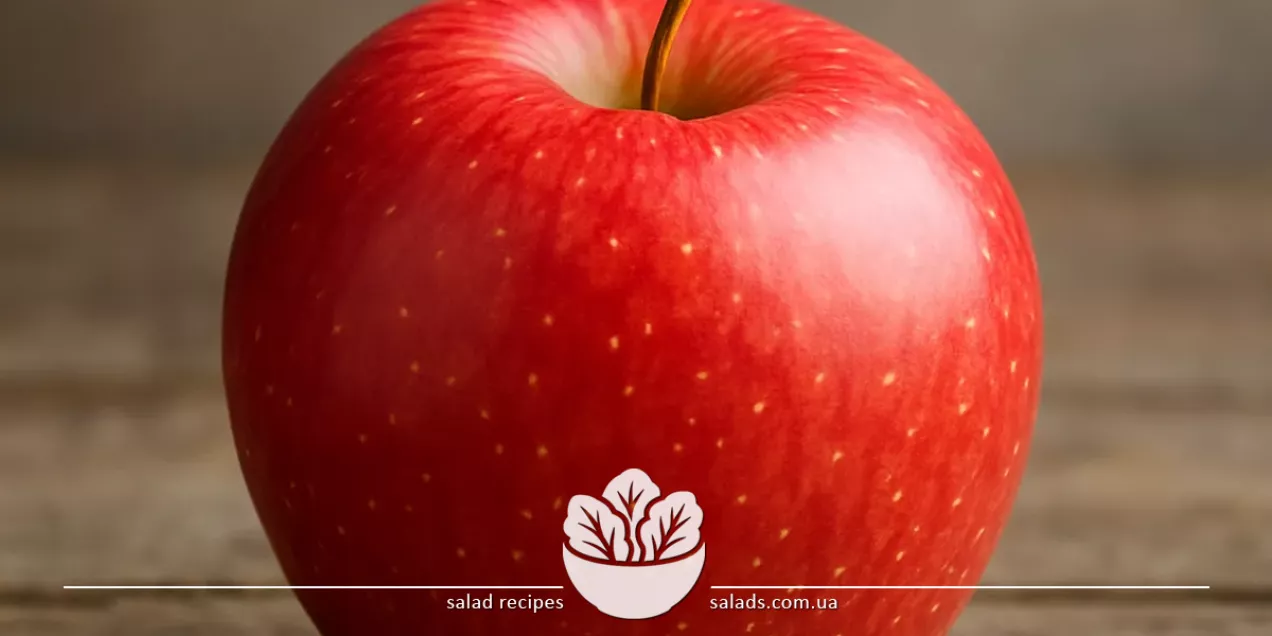Apple

Apple is one of the most popular and versatile fruits, widely used in cuisines around the world. Its taste ranges from sweet and sour to sweet depending on the variety, and its texture can be either crisp or tender. Apples are eaten fresh, used in desserts, added to salads, made into juices, purees, compotes, jams, and even used in hot dishes. In addition to their flavor qualities, apples are rich in vitamins C and B6, fiber, and antioxidants that promote health. Other types and varieties of apples can be found in the apple varieties category.
Salad Recipes with Apples
Salads with apples are very popular due to the combination of freshness, juiciness, and light sweet-and-sour flavor. This fruit is often added to the classic “Olivier” salad for an extra note, as well as to salads with boiled beetroot, prunes, and walnuts, where the apple balances the sweetness of the other ingredients. A very popular option is a salad with cabbage, carrot, and apple – a light and healthy choice for everyday meals. In festive menus, apple pairs wonderfully with chicken fillet, pineapple, and mayonnaise, creating a vibrant flavor in layered salads. Apples are also frequently used in dietary recipes – for example, combined with celery, Greek yogurt, and walnuts. Another interesting option is an autumn salad with apple, grapes, cheese, and lettuce leaves, served with a light mustard-honey dressing.
Nutritional Value and Health Benefits of Apples
Apples are not only delicious but also a healthy fruit, rich in vitamins, minerals, and fiber. They contain vitamins C and B6, potassium, magnesium, and natural antioxidants that strengthen the immune system and support heart function. The fiber in apples helps regulate digestion, supports intestinal microflora balance, and promotes toxin removal. Eating apples positively affects blood sugar levels, reducing the risk of diabetes, and also helps control weight due to prolonged satiety. With their low calorie content and high water content, apples are ideal for the daily diet of both adults and children. One classic combination is the use of apples in dishes with white cabbage. Such salads or stewed dishes offer a balanced sweet-and-sour taste and harmoniously combine the fruit’s freshness with the vegetable’s crisp texture. It’s a popular pairing in many world cuisines, adding freshness and richness to meals.
Pairing Apples with Other Fruits
Apples pair wonderfully with other fruits, making them indispensable in fruit salads, desserts, and beverages. Especially popular are combinations with pears, citrus fruits, berries, and exotic fruits. The variety of textures and flavors in these dishes creates a rich flavor palette – sweet-and-sour, aromatic, and refreshing. Pear, in particular, is a classic partner for apple. These two fruits have similar qualities, yet each brings its own highlight to the dish: apple – bright acidity and juiciness, pear – tenderness and sweetness. Together, they create a perfect balance in salads, compotes, bakes, and pastries. Combining apples and pears is often used in breakfasts, desserts, as well as sweet and sweet-and-sour dishes. This is a classic that remains relevant in any season and cuisine, from European to American.
Apples Combined with Cheese and Nuts
Apples are an excellent ingredient to pair with various types of cheese, especially feta, brie, cheddar, and mozzarella. Their sweet-and-sour freshness enhances the creamy flavor of cheese and brings a harmonious balance to the dish. Apples are often added to cheese salads, cheese tarts, casseroles, or served with cheese platters. In addition to cheese, apples go perfectly with nuts, especially walnuts. Nuts add crunch, richness, and healthy fats, making the dish not only tasty but also nutritious. Walnuts, with their mild yet distinct flavor, excellently highlight the freshness and slight acidity of apples. The combination of apples with feta cheese and walnuts is common in salads and makes a great option for light lunches or appetizers. This duo is ideal for those who value both flavor balance and health benefits.
The Role of Walnuts in Apple-Based Dishes
Walnuts are a valuable ingredient often added to salads, desserts, and snacks together with apples. They provide pleasant crunch, rich aroma, and healthy fats, enhancing both the nutritional value and flavor profile of dishes. Walnuts contain omega-3 fatty acids, proteins, B vitamins, and antioxidants, making them an important part of a healthy diet. Adding walnuts to apple salads or casseroles creates a balanced texture and flavor contrast. They pair well with other ingredients such as fresh carrots, cheese, and greens. This combination increases the nutritional value of the dish and makes it more appealing to the consumer. A great partner for walnuts in apple dishes is shelled walnut. Using shelled nuts makes dishes more visually appealing and convenient to eat, while also highlighting textural nuances. Walnuts combined with apples are a classic pairing for healthy and delicious salads and desserts.
The Role of Carrots in Dishes with Apples and Nuts
Carrot is a versatile vegetable often added to salads, snacks, and desserts along with apples and nuts. It brings natural sweetness, crunch, and vibrant color to dishes, making them more attractive and tasty. Carrots are rich in beta-carotene, vitamins C and K, and fiber, which enhances the nutritional value of the dish. The combination of carrot, apple, and walnut is a classic in many world cuisines. It’s a balanced mix that unites sweetness, acidity, and crunch. Such salads are suitable for light snacks, lunches, and festive tables, as they are not only tasty but also healthy. A great choice for such dishes is the use of fresh carrot, which adds bright notes and deepens the flavor. It blends easily with other ingredients, making dishes harmonious and well-rounded.